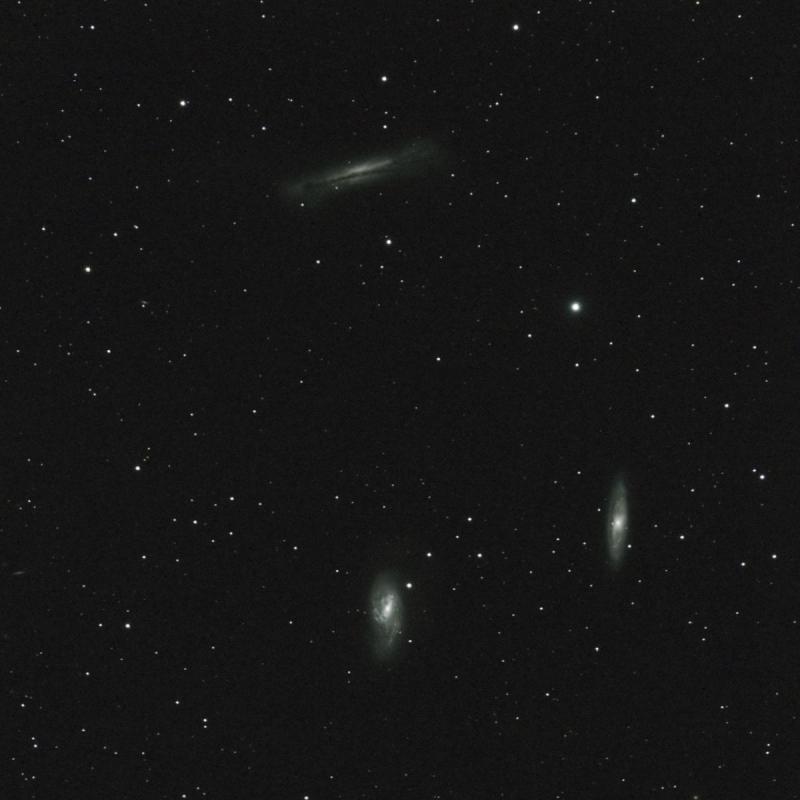
5M6M65, M66, and NGC 3628 (Jon Talbot)
M65
Alternate: NGC 3623
Leo
RA 11h 18.9 m
Dec +13º 05′
Magnitude 9.3
M66
Alternate: NGC 3327
Leo
RA 11h 20.2 m
Dec +12º 59′
Magnitude 9.0
NGC 3628
Alternate: The Hamburger Galaxy, Sarah’s Galaxy
Leo
RA 11h 20 m 17 s
Dec +13º 35′ 23”
Magnitude 10.2
M65, M66, and NGC 3628 are part of a group of galaxies known as the Leo Galaxy Group. This group of galaxies also includes another trio of galaxies M95, M96, and M105. M65 and M66 are a popular pair of galaxies for backyard astronomers to observe, second to only to M81 and M82.
Whereas M95, M96, and M105 can be readily observed with the smaller 4” refractor, M65, M66, and NGC 3628 are a challenge in a 4” because of the difficulty of seeing the edge-on NGC 3628. With an 8” aperture, NGC 3628 can be seen to have a large dark dust lane that extends through the galaxy’s profile, which gives the galaxy its Hamburger Galaxy moniker. The dust lane has the effect of lowering the surface brightness of the object. The 8” aperture of a SCT or Newtonian helps overcome the lower surface brightness.
M65 and M66 are separated by only 21′, with NGC 3628 only 35′ away from M66. Chose an eyepiece that produces a true field of view of 1º, and all three galaxies will fit comfortably in the same eyepiece view. For example, a 28 mm 68ºFOV eyepiece will produce a 0.95ºtrue field of view at 71x in an 8” SCT.
M65 is an Sa galaxy that was discovered by Charles Messier in March 1, 1780. He described M65 as a :
“…nebula discovered in Leo: It is very faint and contains no star.”
M66 is an Sab galaxy discovered by Charles Messier on the same night in 1780 as his discovery of M65. Messier’s description of M66 was:
“…its light is very faint & it is very close to the preceding (M65). They both appear in the same field in the refractor. The comet of 1773 & 1774 has passed between these two nebulae on November 1 to 2, 1773. M. Messier didn’t see them at that time, no doubt, because of the light of the comet.”
Admiral William Henry Smyth described M66 as follows:
“A large elongated nebula, with a bright nucleus, on the Lion’s haunch, trending np [north preceding, NW] and sf [south following, SE]; this beautiful specimen of perspective lies just 3deg south-east of Theta Leonis. It is preceded at about 73s by another of a similar shape, which is Messier’s No. 65, and both are in the field at the same time, under a moderate power, together with several stars.”
NGC 3628 is an unbarred Sa spiral galaxy that was discovered by William Herschel. NGC 3628 was discovered on April 8, 1784, when William Herschel used a larger telescope than that used by Messier. The one month later discovery of NGC 3628 just adds fuel to the old astronomer adage: “Aperture rules!”
Sometime in the distant past, all three of these Leo galaxies, sometimes referred to as the Leo Triplet, had a close gravitational encounter with each other. As a result, M65 is suspected of actually having a central bar, although this is difficult to detect because of its oblique angle to astronomers. Gravitational interaction from its past encounter with neighboring NGC 3628 has resulted in M66 having an extremely high central mass concentration.
Some astronomers include the nearby lenticular galaxy NGC 3593 as a possible member of the M66 Group. NGC 3593 is a starburst galaxy and known to contain two populations of stars that are rotating in opposite directions. With an apparent magnitude of 12.6, the galaxy is fainter than the Leo Triplet, and is on the hairy edge of visibility in an 8” SCT, but visible in larger apertures. NGC 3593 can be viewed as part of this galaxy group by owners of 10” or larger apertured telescopes and very wide field eyepieces.